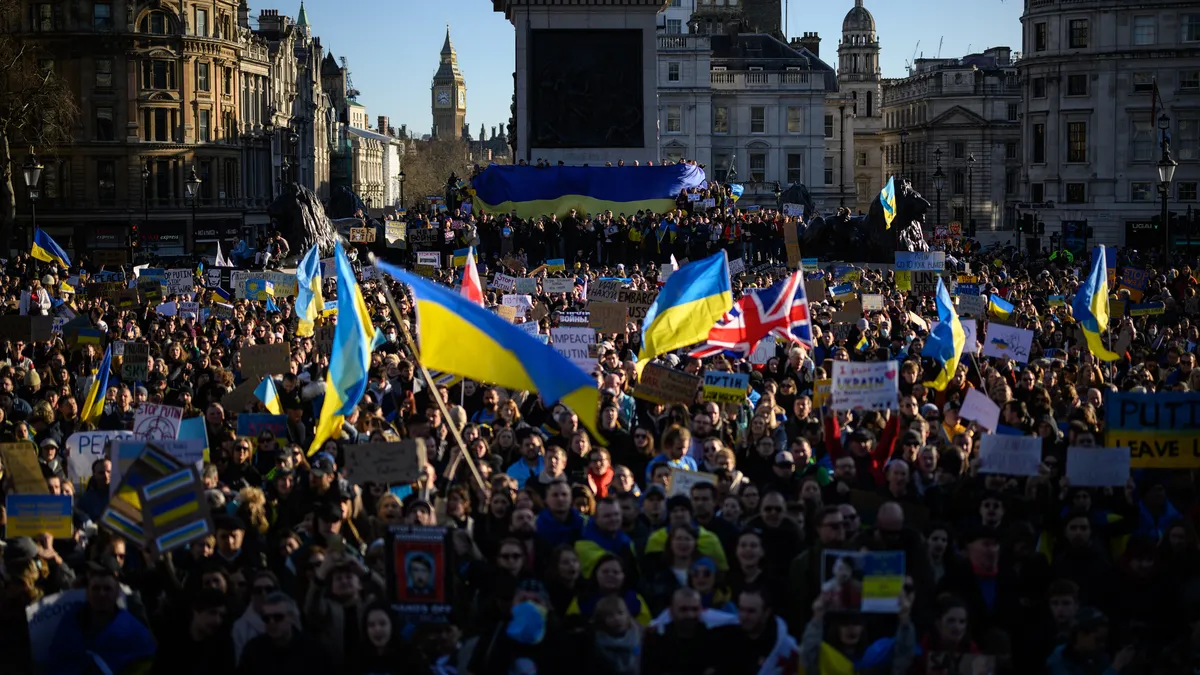Dive Brief:
- Several shocks from the Russian invasion of Ukraine will likely slow U.S. economic growth and stoke inflation well above the Federal Reserve’s 2% target through 2023, the Conference Board said Thursday, emphasizing the impact from higher energy prices.
- The surge in prices for oil, gas, grains and other commodities will probably add 0.8 percentage point to 2.5 percentage points to U.S. inflation this year and reduce growth from 0.3 percentage point to 0.8 percentage point, the Conference Board said.
- “What we're seeing is five or six simultaneous shocks from the war in Ukraine having deleterious effects not only on economies and peoples in the region, but throughout the world,” Conference Board Chief Economist Dana Peterson said during a webcast. “The inflationary effects are quite acute in the U.S.,” she added, noting that lockdowns in China have worsened pandemic-induced constraints on global supply chains.
Dive Insight:
The consumer price index on a 12-month basis jumped 8.5% in March, while the producer price index, a measure of suppliers’ costs to businesses, soared 11.2%.
CFOs and their C-suite colleagues may try to blunt the harm from accelerating inflation by adopting automation and relying more on contractors or remote work from areas with lower-cost labor, Peterson said. “All in all, we do believe that inflation is probably going to be with us for longer."
U.S. inflation surged to a four-decade high well before Russia attacked Ukraine. Price pressures may peak during the current quarter, Peterson said. But a lengthy war would cloud the outlook for inflation while posing significant challenges to global trade, finance and economic growth.
Fed Governor Lael Brainard said Tuesday that the central bank will quickly move to curb inflation while noting the challenge for any central bank to influence supply across an economy. “We’re committed to bringing inflation back down to 2%,” Brainard said, ranking the effort as the Fed’s “most important task.”
Plans by the central bank to increase the federal funds rate and trim its $9 trillion balance sheet “will bring the policy stance to a more neutral posture expeditiously later this year,” according to Brainard, who is awaiting Senate confirmation as Fed vice chair.
Reducing price pressures poses an unusually difficult challenge for policymakers, Peterson said.
“Certainly I think they've abandoned expectations that there's going to be kind of a natural solution to inflation, especially given the fact that you have the supply side shocks that are external, meaning commodity prices rising and supply chain disruptions still happening,” she said.
“I would imagine the Fed is going to be fully aware that there's nothing they can do about those issues, and that they will do all they can to address the more domestic drivers of inflation,” she said. “They're also going to have to recognize that they may not get back to a 3%, 2% [inflation] target anytime soon” without running the risk of triggering a recession.
The Fed will probably begin trimming its balance sheet by $95 billion every month and raise the main interest rate to 2% this year and close to 3% in 2023, Peterson said.
The central bank will likely increase the federal funds rate by a half point at the end of a two-day meeting on May 4, according to analysts’ predictions and measures of investor expectations. Policymakers in March signaled the possibility of such an increase, according to minutes of their meeting released last week.
The Fed raised the benchmark interest rate by a quarter point last month in the first reduction of accommodation since 2018. It confronts the challenge of increasing borrowing costs enough to curb inflation but not so high that it undercuts employment or economic growth, economists said.
Policymakers target inflation based on the core personal consumption expenditures (PCE) price index. Core PCE surged in February to a record high of 5.4% compared with the prior year, according to the Labor Department.
The Russian invasion of Ukraine may have an impact far beyond prices and growth, heralding the end of the global political and economic order that has prevailed for more than seven decades, according to Lori Esposito Murray, president of the committee for economic development at the Conference Board’s Public Policy Center.
“I really want to emphasize that when we're talking about Russia's invasion of Ukraine – the war in Ukraine – this is not just about Russia and Ukraine, it is really about the changing world order,” Murray said.
Russia, China and India may eventually align behind a financial and economic system that is separate from the order sustained by U.S., E.U. and other democratic, free-market economies, she said. “No matter how it ends, we are completely disrupting the international world order and we'll be dealing with a very, very different environment.”













